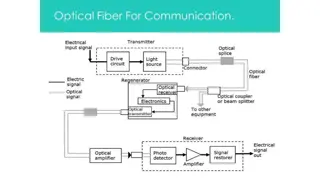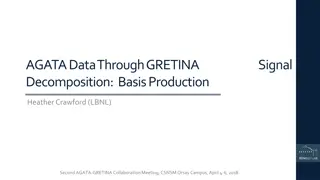Understanding Data and Signals in Networks
Data transmission involves converting information into electromagnetic signals for communication. Analog data is continuous, like a clock's hands, while digital data is discrete, like binary code in computer memory. Signals can be analog or digital, periodic or non-periodic, with characteristics like frequency and phase. This chapter delves into the concepts of data and signals, exploring the differences between analog and digital forms and the properties of periodic and non-periodic signals.
Download Presentation

Please find below an Image/Link to download the presentation.
The content on the website is provided AS IS for your information and personal use only. It may not be sold, licensed, or shared on other websites without obtaining consent from the author. Download presentation by click this link. If you encounter any issues during the download, it is possible that the publisher has removed the file from their server.
E N D
Presentation Transcript
Chapter Three Data and Signals Introduction: - Generally, the data usable to a person or application are not in a form that can be transmitted over a network. For example, a photograph must first be changed to a form that transmission media can accept. Transmission media work by conducting energy along a physical path. Note: - To be transmitted, data must be transformed to electromagnetic signals. ANALOGAND DIGITAL Data digital. Analog data refers to information that is continuous. For example, an analog clock that has hour, minute, and second hands gives information in a continuous form; the movements of the hands are continuous. Analog data, such as the sounds made by a human voice, take on continuous values. When someone speaks, an analog wave is created in the air. This can be captured by a microphone and converted to an analog signal or sampled and converted to a digital signal. can be analog or Digital data refers to information that has discrete states. For example, a digital clock that reports the hours and the minutes will change suddenly from 8:05 to 8:06. Digital data take on discrete values. For example, data are stored in computer memory in the form of 0s and 1s. They can be converted to a digital signal or modulated into an analog signal for transmission across a medium. Note: - Data can be analog or digital. Analog data are continuous and take continuous values. Digital data have discrete states and take discrete values. The simplest way to show signals is by plotting them on a pair of perpendicular axes. The vertical axis represents the value or strength of a signal. The horizontal axis represents time. Figure 3.1 illustrates an analog signal and a digital signal. The curve representing the analog signal passes through an infinite number of points. The vertical lines of the digital signal, however, demonstrate the sudden jump that the signal makes from value to value. Figure (3.1) Comparison ofanalog and digital signals 1
Periodic and Non-periodic Signals: - Both analog and digital signals can take one of two forms: periodic or non-. A periodic signal completes a pattern within a measurable time frame, called a period, and repeats that pattern over subsequent identical periods. The completion of one full pattern is called a cycle. Anon-periodic signal changes without exhibiting a pattern or cycle that repeats over time. Note: - In data communications, we commonly use periodic analog signals and non-periodic digital signals. PERIODIC ANALOG SIGNALS:-Periodic analog signals can be classified as simple or composite. A simple periodic analog signal, a sine wave, cannot be decomposed into simpler signals. A composite periodic analog signal is composed of multiple sine waves. Sine wave:- Figure 3.2 shows a sine wave Figure (3.2) a sine wave Asine wave can be represented by three parameters: the peak amplitude, the frequency, and the phase. These three parameters fully describe a sine wave. Figure (3.3) two signals with the same phase and frequency, but different amplitudes Period and Frequency: - Period refers to the amount of time, in seconds, a signal needs to complete 1 cycle. Frequency refers to the number of periods in 1 s. Period is the inverse of frequency, and frequency is the inverse of period, as the following formulas show. 2
1 ? ? 1 ? ? ?? = ?? = Figure 3.4 shows two signals and their frequencies. Figure (3.4) two signals with the same amplitude and phase but different frequencies Note: - If a signal does not change at all, its frequency is zero. If a signal changes instantaneously, its frequency is infinite. Phase:-The term phase describes the position of the waveform relative to time 0. If we think of the wave as something that can be shifted backward or forward along the time axis, phase describes the amount of that shift. It indicates the status of the first cycle. Phase is measured in degrees or radians [360 is 2n rad; 1 is 2n/360 rad, and 1 rad is 360/ (2n)]. A phase shift of 360 corresponds to a shift of a complete period; a phase shift of 180 corresponds to a shift of one-half of a period; and a phase shift of 90 corresponds to a shift of one-quarter of a period (see Figure 3.5). 3
Figure 3.5 Three sine waves with the same amplitude andfrequency, but different phases Example:-Asine wave is offset 1/6 cycle with respect to time 0. What is its phase in degrees and radians? Solution We know that 1 complete cycle is 360 . Therefore, 1/6 cycle is Wavelength: - wavelength is another characteristic of a signal traveling through a transmission medium. Wavelength binds the period or the frequency of a simple sine wave to the propagation speed of the medium (see Figure 3.6). Figure (3.6) Wavelength and period 4
Time and Frequency Domains: - a sine wave is comprehensively defined by its amplitude, frequency, and phase. We have been showing a sine wave by using what is called a time-domain plot. The time- domain plot shows changes in signal amplitude with respect to time (it is an amplitude-versus- time plot).To show the relationship between amplitude and frequency, we can use what is called a frequency-domain plot. A frequency-domain plot is concerned with only the peak value and the frequency. Figure 3.7 shows a signal in both the time and frequency domains. Figure (3.7) the time-domain and frequency-domain plots of a sine wave The frequency domain is more compact and useful when we are dealing with more than one sine wave. For example, Figure 3.8 shows three sine waves, each with different amplitude and frequency. All can be represented by three spikes in the frequency domain. Figure (3.8) the time domain and frequency domain of three sine waves 5
Composite Signals: -So far, we have focused on simple sine waves. useful in data communications; we need to send a composite signal, a signal made of many simple sine waves. We can send a single sine wave to carry electric energy from one place to another. For example, the power company sends a single sine wave with a frequency of 60 Hz to distribute electric energy to houses. As another example, we can use a single sine wave to send an alarm to a security center when a burglar opens a door or window in the house. In the first case, the sine wave is carrying energy; in the second, the sine wave is a signal of danger. If we had only one single sine wave to convey a conversation over the phone, it would make no sense and carry no information. We would just hear a buzz. A composite signal is made of many simple sine waves. A single frequency sine wave is not According to Fourier analysis, any composite signal is a combination of simple sine waves with different frequencies, amplitudes, and phases. A composite signal can be periodic or non-periodic. A periodic composite signal can be decomposed into a series of simple sine waves with discrete frequencies, frequencies that have integer values (1, 2, 3, and so on). A non-periodic composite signal can be decomposed into a combination of an infinite number of simple sine waves with continuous frequencies, frequencies that have real values. Example: -Figure 3.9 shows a periodic composite signal with frequency f. This type of signal is not typical of those found in data communications. We can consider it to be three alarm systems, each with a different frequency. The analysis of this signal can give us a good understanding of how to decompose signals. Figure (3.9) a composite periodic signal It is very difficult to manually decompose this signal into a series of simple sine waves. However, there are tools, both hardware and software, that can help us do the job. We are not concerned about how it is done; we are only interested in the result. Figure 3.10 shows the result of decomposing the above signal in both the time and frequency domains. 6
Figure (3.10)decomposition of a composite periodic signal in the time and frequency domains Example: - Figure 3.11 shows a non-periodic composite signal. It can be the signal created by a microphone or a telephone set when a word or two is pronounced. In this case, the composite signal cannot be periodic; because that implies that we are repeating the same word or words with exactly the same tone. Figure (3.11) the time and frequency domains of a non-periodic signal Bandwidth: - The range of frequencies contained in a composite signal is its bandwidth. The bandwidth is normally of a composite signal is the difference between the highest and the lowest frequencies contained in that signal. For example, if a composite signal contains frequencies between 1000 and 5000, its bandwidth is 5000 - 1000, or 4000. 7
Figure (3.12) the bandwidth of periodic and non-periodic composite signals Digital Signals In addition to being represented by an analog signal, information can also be represented by a digital signal. For example, a 1 can be encoded as a positive voltage and a 0 as zero voltage. A digital signal can have more than two levels. In this case, we can send more than 1 bit for each level. Figure 3.13 shows two signals, one with two levels and the other with four. 8
Figure (3.13) two digital signals: one with two signal levels and the other with four signal levels Rate: - Most digital signals are non-periodic, appropriate characteristics. Another term-bit rate (instead of frequency)-is used to describe digital signals. The bit rate is the number of bits sent in 1s, expressed in bits per second (bps). Figure 3.13 shows the bit rate for two signals. Bit and thus period and frequency are not Example: - A digitized voice channel, is made by digitizing a 4-kHz bandwidth analog voice signal. We need to sample the signal at twice the highest frequency (two samples per hertz). We assume that each sample requires 8 bits. What is the required bit rate? Solution The bit rate can be calculated as 2 x 4000 x 8 =64,000 bps =64 kbps Bit Length: - We discussed the concept of the wavelength for an analog signal: the distance one cycle occupies on the transmission medium. We can define something similar for a digital signal: the bit length. The bit length is the distance one bit occupies on the transmission medium. Bit duration length =propagation speed x bit Digital Signal as a Composite Analog Signal: - A digital signal, in the time domain, comprises connected vertical and horizontal line segments. A vertical line in the time domain means a frequency of infinity (sudden change in time); a horizontal line in the time domain means a frequency of zero (no change in time). Going from a frequency of zero to a frequency of infinity (and vice versa) implies all frequencies in between are part of the domain. Fourier analysis can be used to decompose a digital signal. If the digital signal is periodic, which is rare in data communications, frequency domain representation with an infinite bandwidth and discrete frequencies. If the digital signal is non-periodic, the decomposed signal still has an infinite bandwidth, but the frequencies are continuous. Figure 3.14 shows a periodic and a non-periodic digital signal and their bandwidths. the decomposed signal has a Figure (3.14) the time and frequency domains of periodic and non-periodic digital signals 9
Transmission of Digital Signals: - We can transmit a digital signal by using one of two different approaches: baseband transmission or broadband transmission (using modulation). Baseband Transmission: - Baseband transmission means sending a digital signal over a channel without changing the digital signal to an analog signal. Figure 3.15 shows baseband transmission. Figure (3.15) Baseband transmission Broadband Transmission (Using Modulation):- Broadband transmission or modulation means changing the digital signal to an analog signal for transmission. Modulation allows us to use a bandpass channel-a channel with a bandwidth that does not start from zero. This type of channel is more available than a low-pass channel. Figure (3.16) Modulation of a digital signal for transmission on a bandpass channel TRANSMISSION IMPAIRMENT Signals travel through transmission media, which are not perfect. The imperfection causes signal impairment. This means that the signal at the beginning of the medium is not the same as the signal at the end of the medium. What is sent is not what is received. Three causes of impairment are attenuation, distortion, and noise (see Figure 3.17). 10
Figure 3.17 Causes of impairment Attenuation: - Attenuation means a loss of energy. When a signal, simple or composite, travels through a medium, it loses some of its energy in overcoming the resistance of the medium. To compensate for this loss, amplifiers are used to amplify the signal. Figure 3.18 shows the effect of attenuation and amplification. Figure (3.18)Attenuation The decibel (dB) measures the relative strengths of two signals or one signal at two different points. ? ????= 10log10 1 ?? Example: - Suppose a signal travels through a transmission medium and its power is reduced to one- half. This means that P2 is (1/2) P1. In this case, the attenuation (loss of power) can be calculated as:- Example: -One reason that engineers use the decibel to measure the changes in the strength of a signal is that decibel numbers can be added (or subtracted) when we are measuring several points (cascading) instead of just two. In Figure 3.19 a signal travels from point 1 to point 4. In this case, the decibel value can be calculated as:- 11
Figure (3.19)Decibels for example above Distortion: - Distortion means that the signal changes its form or shape. Differences in delay may create a difference in phase if the delay is not exactly the same as the period duration. In other words, signal components at the receiver have phases different from what they had at the sender. The shape of the composite signal is therefore not the same. Figure 3.20 shows the effect of distortion on a composite signal. Figure (3.20) Distortion Noise: - Noise is another cause of impairment. Several types of noise, such as thermal noise, induced noise, crosstalk, and impulse noise, may corrupt the signal. Thermal noise is the random motion of electrons in a wire which creates an extra signal not originally sent by the transmitter. Induced noise comes from sources such as motors and appliances. These devices act as a sending antenna, and the transmission medium acts as the receiving antenna. Crosstalk is the effect of one wire on the other. One wire acts as a sending antenna and the other as the receiving antenna. Impulse noise is a spike (a signal with high energy in a very short time) that comes from power lines, lightning, and so on. Figure 3.21 shows the effect of noise on a signal. Figure (3.21) Noise 12
Signal to Noise Ratio (SNR) To measure the quality of a system the SNR is often used. It indicates the strength of the signal with respect to the noise power in the system. It is the ratio between two powers. It is usually given in dB and referred to as SNRdB. Example: - The power of a signal is 10 mW and the power of the noise is 1 W; what are the values of SNR and SNRdB? Solution The values of SNR and SNRdB can be calculated as follows: Figure (3.22) two cases of SNR: a high SNR and a low SNR DATARATE LIMITS A very important consideration in data communications is how fast we can send data, in bits per second over a channel. Data rate depends on three factors: 1. The bandwidth available 2. The level of the signals we use 3. The quality of the channel (the level of noise) Two theoretical formulas were developed to calculate the data rate: one by Nyquist for a noiseless channel, another by Shannon for a noisy channel. 13
Capacity of the system: - The bit rate of a system increases with an increase in the number of signal levels we use to denote a symbol. Asymbol can consist of a single bit or n bits. The number of signal levels = 2n. As the number of levels goes up, the spacing between level decreases -> increasing the probability of an error occurring in the presence of transmission impairments. Nyquist theorem:- Nyquist gives the upper bound for the bit rate of a transmission system by calculating the bit rate directly from the number of bits in a symbol (or signal levels) and the bandwidth of the system (assuming 2 symbols/per cycle and first harmonic). Nyquist theorem states that for a noiseless channel: ??= 2 ?? log2 ?? When C= capacity in bps, B = bandwidth in Hz, and L=no. of levels=2n Shannon s Theorem: - Shannon s theorem gives the capacity of a system in the presence of noise. ??= ??log2(1 + ??????) Note:- The Shannon capacity gives us the upper limit; the Nyquist formula tells us how many signal levels we need. PERFORMANCE One important issue in networking is the performance of the network, how good is it? In networking, we use the term bandwidth in two contexts. The first, bandwidth in hertz, refers to the range of frequencies in a composite signal or the range of frequencies that a channel can pass. The second, bandwidth in bits per second, refers to the speed of bit transmission in a channel or link. Often refers to capacity. Throughput: - The throughput is a measure of how fast we can actually send data through a network. Although, at first glance, bandwidth in bits per second and throughput seem the same, they are different. A link may have a bandwidth of B bps, but we can only send T bps through this link with T always less than B. For example, we may have a link with a bandwidth of 1 Mbps, but the devices connected to the end of the link may handle only 200 kbps. This means that we cannot send more than 200 kbps through this link. 14
Homework: A network with bandwidth of 10 Mbps can pass only an average of 12,000 frames per minute with each frame carrying an average of 10,000 bits. What is the throughput of this network? Latency (Delay):- The latency or delay defines how long it takes for an entire message to completely arrive at the destination from the time the first bit is sent out from the source. We can say that latency is made of four components: propagation time, transmission time, queuing time and processing delay. ??????????????= ??????????????????????????????+ ????????????????????????????????+ ??????????????????????+ ?????????????????????????????? Propagation Time: - Propagation time measures the time required for a bit to travel from the source to the destination. The propagation time is calculated by dividing the distance by the propagation speed. ???????????????? ??????????????= ??????? ??????? ??????????????? The propagation speed of electromagnetic signals depends on the medium and onthe frequency of the signal for example, in a vacuum, light is propagated with a speed of 3 108??/??. It is lower in air; it is much lower in cable. Homework: - What is the propagation time if the distance between the two points is 12,000 km? Assume the propagation speed to be 2.4 108??/??in cable. Transmission time: - In data communications we don't send just 1 bit, we send a message. The first bit may take a time equal to the propagation time to reach its destination; the last bit also may take the same amount of time. However, there is a time between the first bit leaving the sender and the last bit arriving at the receiver. The first bit leaves earlier and arrives earlier; the last bit leaves later and arrives later. The time required for transmission of a message depends on the size of the message and the bandwidth of the channel. ???????????? ???????? ??????????????????? Queuing Time: - The third component in latency is the queuing time, the time needed for each intermediate or end device to hold the message before it can be processed. The queuing time is not a fixed factor; it changes with the load imposed on the network. When there is heavy traffic on the network, the queuing time increases. An intermediate device, such as a router, queues the arrived messages and processes them one by one. If there are many messages, each message will have to wait. Bandwidth-Delay Product: - Bandwidth and delay are two performance metrics of a link. However, what is very important in data communications is the product of the two, the bandwidth-delay product. Let us elaborate on this issue, using two hypothetical cases as examples. Case 1:- Let us assume that we have a link with a bandwidth of 1 bps (unrealistic, but good for demonstration purposes). We also assume that the delay of the link is 5 s. We want to see what the bandwidth-delay product 15
means in this case. Looking at figure, we can say that this product 1 x 5 is the maximum number of bits that can fill the link. There can be no more than 5 bits at any time on the link. Figure (3.23) Figure (3.23) Filling the link with bits for case 1 Case 2:- Now assume we have a bandwidth of 5 bps. Figure 3.24 shows that there can be maximum 5 x 5 = 25 bits on the line. The reason is that, at each second, there are 5 bits on the line; the duration of each bit is0.2 s. Figure (3.24)Filling the link with bits in case 2 We can think about the link between two points as a pipe. The cross section of the pipe representsthe bandwidth, and the length of the pipe represents the delay. We can say the volume of the pipedefines the bandwidth-delay product, as shown in Figure 3.25. 16























